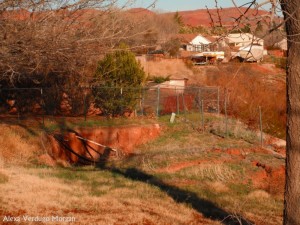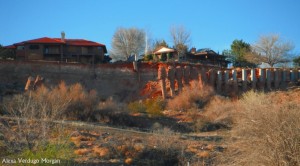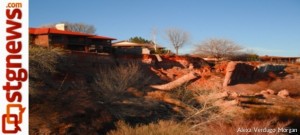
SANTA CLARA – A portion of the Santa Clara Heights near Truman Drive has grappled with the danger of sliding land for over 30 years and despite numerous efforts by the City of Santa Clara to stop it, there is still no solution in sight.

Geologic history and cause
The Santa Clara Heights is built upon the Santa Clara Bench, a natural plateau bordered by the Santa Clara River Valley to the southwest and a small tributary stream to the northeast. Like most of Southern Utah, the soil of the Santa Clara Bench is mainly composed of petrified forest member, commonly called “blue clay,” along with sediment from the Santa Clara River. Petrified forest member is a weak rock that swells quickly and moves easily when wet.
Natural groundwater, along with runoff from developments, has saturated and softened the soil of the Santa Clara Bench over the last three decades, triggering movement. A pair of major landslides in 1992 and 2002 destroyed a portion of Truman Drive, forced the evacuation of three houses and is immediately threatening two more. Numerous efforts have tried, and failed, to slow down or stop the slide.
The city owns all of the property on which the Santa Clara Heights is built and will bear the cost of any construction.
“The city council has asked the Santa Clara Hillside Committee to come up with suggestions on how to slow down or stop the slide,” Santa Clara Public Services Director Jack Taylor said. “Every one of their ideas so far has been very expensive and we don’t know how to come up with the funds.”
Timeline
- 1975 – Development in the Santa Clara Heights began near the east end of the plateau, extending to Truman Drive and beyond by the early 1980s.
- 1981 – The first geologic instability in the Heights, a minor rotational failure in the clays near Truman Drive, was reported by the Utah Geological Survey Geologic Hazards Division.
- 1992 – The first major landslide in the Heights destroyed a portion of Truman Drive and encroached on the backyards of houses on nearby Cinnamon Circle and Chapel Street.
- 1992 – The city re-graded the surface and constructed a rock berm at the base of the slide in an effort to restore the hill to its original configuration.
- 1993 – Large cement shafts were installed above the slide area, behind the affected homes in Cinnamon Circle, in an effort to isolate the slope. The shafts extended between 20 and 40 feet into the shale bedrock under the hill.
- 1994 – Additional landslides occurred west of the affected area, destroying a portion of the Santa Clara Field and Canal Company canal at the base of the hill.
- 1996 – The city installed a drain on Desert Dawn Drive in an effort to collect and redirect the hill’s groundwater.
- 2002 – Another major landslide forced residents to vacate two homes on the top of the hill and one at the base, which the city later purchased. Most of the cement shafts were also displaced and the drain pipe damaged.
- 2002 – A concrete wall was installed on Truman Drive to intercept water runoff from roads further uphill and redirect it away from the affected area.
- 2005 – Additional movement of the western slide expanded the affected area further towards Truman Drive.
- 2006 – Drains were installed in the western slide to collect and redirect groundwater.
- 2012 – Despite all past efforts, the affected area has continued expanding and the land sliding.
Current status
With no effective means currently in place to slow down or stop the slide, two houses are in immediate danger. One is abandoned and owned by the city but the other, located at 1656 Cinnamon Circle, is occupied. A portion of its backyard has already been lost to the slide and another part is collapsing; structural damage appears to be an imminent possibility.

“We are concerned for the property owners,” Santa Clara Mayor Rick Rosenberg said.
St. George News spoke with the homeowner, Judy Larsen, but she declined to comment.
In February 2013, the Santa Clara Hillside Committee met with Bill Lund, a senior scientist with the Utah Geological Survey, to inspect the affected area and discuss possible solutions. Lund conducted the original inspection of the area in 1981 and has been monitoring the slide’s progress since. After his recent visit, he sent a letter to the city detailing his recommended solutions.
“The best way to stabilize the slope is to dry it out. If it’s not dried out, it will never stop weakening and sliding,” Lund said. “The question isn’t whether it can be stopped, it’s whether the city can afford to stop it. We have to find a solution that’s within practical cost parameters.”
A community meeting was held at the Santa Clara City Hall in early March to update residents on the current status of the slide. No action based on the recommendations of Lund or the committee has been taken yet.

Future danger
The issue of unstable ground is not isolated to the Truman Drive area; all of the Santa Clara Heights, especially homes situated near the edge of the bench, could potentially be threatened by landslides in the coming years. Natural groundwater and petrified forest member exist throughout the bench and as long as people live atop it, the problem will be present.
“It’s spreading along all the hills in the Heights,” Taylor said. “We don’t know what the slide will do in the future.”
In an area where petrified forest member is widespread and landslides are often a concern, it is very difficult to predict, even with advanced geologic science, when a hazard will occur. “When subdivisions are planned, they have a geotechnical study done that looks for potential issues such as landslides. If any are discovered, mitigating actions must be taken to ensure the safety of the development,” Lund said. “But obviously, no one saw this coming.”
Email: [email protected]
Copyright St. George News, SaintGeorgeUtah.com LLC, 2013, all rights reserved.

To quote from the article: “When subdivisions are planned, they have a geotechnical study done that looks for potential issues such as landslides. If any are discovered, mitigating actions must be taken to ensure the safety of the development,” Lund said. “But obviously, no one saw this coming.”
Could that be because everyone who “looked” was “encouraged” to look the “other way?” Looks to me like another case of “GOODOLEBOYISM” at it’s finest.
When this area was considered for construction, nobody really understood the effects of blue clay on homes and roadways. After homes were built and landscaping was watered for years and years, things started to move. Slopes usually move first, well , because that’s how slopes are formed. Slopes erode and slowly eat away material and move it down and away. Homes are lifted by the clay and roads turn into “rodeo drive” So it’s no surprise that this slope is failing or any other slope for that matter. No surprise that rocks break off and land on house’s either. That’s just nature doing it’s thing. There’s no “Goodolboyism” going on here. Many lessons have been learned from Truman drive and homes in this area.
Here’s your solution: Tiebacks! Keeping water away from the slide is a good idea, but the cost-benefit ratio is iffy, at best. If they want to fix the problem with one solution with a high probability of success, do a geotech study (install inclinometers to define the slide plane(s)), and design a tieback system to hold the slope in place. Expensive, but works. For more help, the City could more or less mimic what AZ is doing with the Hwy 89 slide that occurred in Feb 2013: http://www.azdot.gov/us89/
You are correct, Don. The geotech conditions in that area are riddled with red flags labeled “Landslide-Prone Area”, not to mention “Warning: Expansive Soil Will Heave Slabs and Foundations”. Clearly, they were ignored.
Everything seemed to work out well for Santa Clara during the great drought. Rainfall since the early 2000 have caused serious problems for the city. They seem very reluctant to accept the changing weather pattern of the area. The most resent example is the levee failure which they had significant reports on the imminent failure of dating back if my memory is correct to the mid 90’s. The policy of deal with it when it happens is very unnerving. My biggest concern is what happens if the earth shakes the area. The operating force we are dealing with now is gravity slow and sure. As far as I can tell they seem to want to leave it up to FEMA after the fact.
I’ve always liked Santa Clara Mayor Rosenberg in his profession as an engineer but he sure is short on ideas on this issue where engineers need to be long in the tooth and the pen. All he can say is that he is concerned about citizens? That concern was obvious several mayors ago. What is his solution?
Can you imagine the day when Santa Clara heights is a wasteland and the Santa Clara City corporation is bankrupt from paying market value for all the homes destroyed by the city’s actions? The author did fail to mention why it is the city is willing to buy all the condemned lands. The answer: because Santa Clara city is the first party to disturb the slope in a material way. Ever since that slope has been sluffing like a high school teenager sluffs seminary. Santa Clara city admits it caused the problem.
Whether you live at the bottom of a cliff where boulders roll down, or at the top, where it slides from under you, you’re at risk, no matter what the rock or soil are like, though some are worse than others.
Mountains and cliffs have ONE MISSION: TO FALL DOWN. It is what God created them to do. And they do it well, and not on our schedule.
Not sure who is to blame. Any competent geotech (wondering who it was) has no excuse not to recognize the problem BEFORE construction (sorry Brock, but engineers don’t design based on a short-term basis; in other words, the recent rain, or even a pending earthquake, aren’t relevant – the design for a development like SC Heights would consider at least a 50-yr timeframe, based on historic data, but not only that, it would include a “factor of safety” that accounts for anything unknown). Whether we are in a “great drought” or a few years of “wet”, it doesn’t matter. These fluctuations should be factored into a development that meant to last for more than 50 years (or more, of course). Anyway, either the geotech failed to raise the flag, or they did, and the City/Developers/Contractors ignored it, but it’s too late to sue anyone (I think), the Statute for such has run. JJ Slice, i was thinking the same thing: the City says they’re concerned about citizens, but being a geotech myself, it’s a no-brainer that this can be fixed (see my previous comment). The fact that they haven’t in decades, when the technology has been available, is inexcusable. Modifying or diverting drainage is always a good idea, but when things are this bad, it’s just not enough. I have trouble believing our local govt’s are that hurting for money, and even if they are, they need to step up and do their job: fix what they’re responsible for, rather than try to appease the victims with words of concern and drainage improvements that more than likely won’t work. Tiebacks guys, tiebacks.
Dan, i like and dislike your comment at the same time. I agree that God/Nature will have it’s ways, which are more powerful than us. But God/Nature also created us, and we have developed the know-how and technology to deal with these things, within reason of course. There is a difference between the “freak event” and the one that could have been prevented. This is the latter. Period. I drive by that thing every day, and never get tired of marveling over the ignorance that went into it. I sure hope innocent homeowners aren’t paying the price for others’ negligence. Overall, your comment is an insult to how far we’ve come scientifically, and a cop-out excuse for those responsible.
Oh yeah, Alvin: same thing – nature’s ways are no excuse for this. Unless this area has been living in some sort of cave, oblivious of what the rest of the world knows (which actually seems plausible), there is no excuse for this! Geotech engineering has been around for quite a while, certainly before the 70’s, but actually since before we started recording history. Your comment is an insult to humankind, and you obviously have no idea what you’re talking about. Sorry, not trying to be insulting, just speaking the truth. There is no good excuse for this. Period.
Its all about the tax base generation!!! “If we give them a view, they will pay for it” How about not building your house on sand? (or in this case, blue clay. Build it on a rock!!!! Come up with ways to eliminate the natural movement of land? Kind of like trying to tell the Virgin or Santa Clara Rivers to stay in their banks. Quit building in areas prone to natural occuring trends. Insanity is defined as “doing the same thing pver and over and expecting different results. Oh yeah, quit wasting tax payers money trying to accomplish the impossible.
I am surprised that the ‘fix’ was not made prior to the construction of the Town Hall. I cannot understand why that was a higher priority?